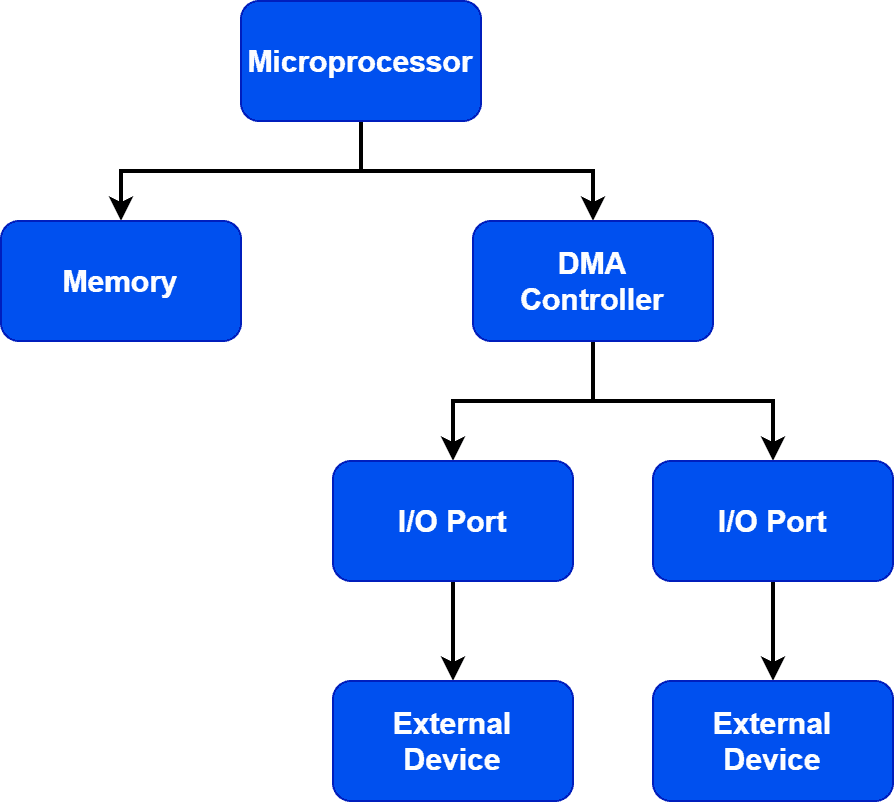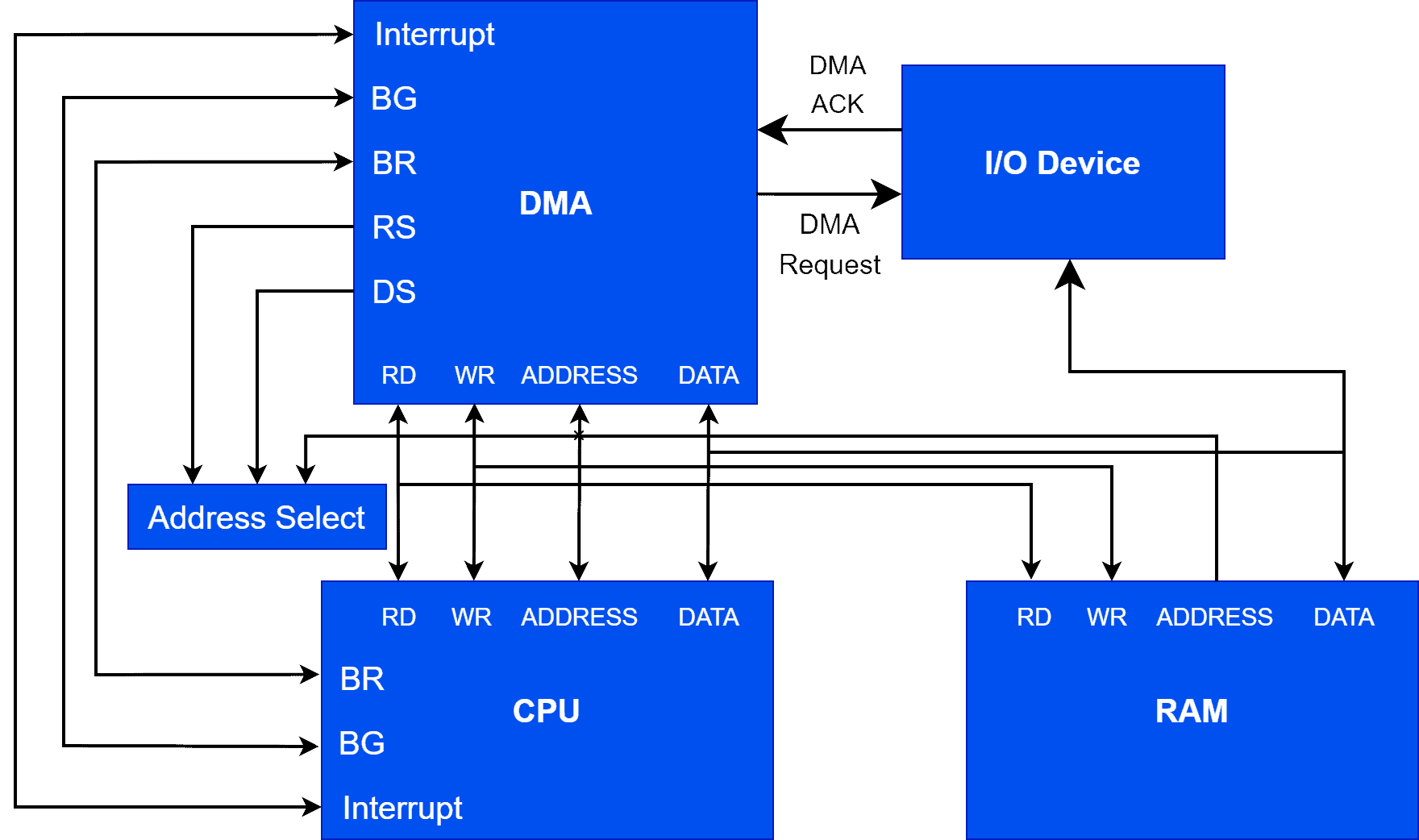1. 概述
本文将深入讲解 DMA(Direct Memory Access,直接内存访问) 的工作原理。我们将从其工作机制、类型、优缺点等多个方面进行解析。
同时,也会涵盖 DMA 控制器的寄存器结构、工作流程以及其在现代系统中的实际应用场景。
2. 简介
在现代数字世界中,设备与计算机之间的数据交换无时无刻不在进行。但计算机系统的数据处理速度是有限的,随着各种设备(如传感器、打印机、高速调制解调器)的普及,CPU 成为了数据传输的瓶颈。
如果所有数据传输都由 CPU 负责,CPU 将无法同时执行其他任务。为了解决这个问题,引入了 DMA 控制器,它可以在不占用 CPU 的情况下,实现设备与内存之间的数据传输。
DMA 是一种允许设备直接与主内存交换数据的技术。它不仅提高了数据传输效率,还减轻了 CPU 的负担。常见的应用场景包括:从传感器读取数据、写入存储设备、发送数据到打印机或网络等。
DMA 控制器通过专用的数据通道实现数据传输,这些通道分为两类:
- 数据通道:用于传输实际数据
- 控制通道:用于控制数据传输的流程
3. DMA 的类型
根据数据传输方式的不同,DMA 控制器主要分为以下几种类型:
✅ 单端 DMA(Single-ended DMA)
最简单的形式,一次只能读写一个内存地址。
✅ 双端 DMA(Dual-ended DMA)
可以同时读写两个内存地址,适用于更复杂的数据流处理。
✅ 仲裁式 DMA(Arbitrated-ended DMA)
支持多个内存地址的读写,适用于多设备并发传输。
✅ 交错式 DMA(Interleaved DMA)
可在读取一个地址的同时写入另一个地址,实现高效的数据搬移。
4. 工作流程
DMA 控制器虽然在 CPU 之下工作,但其数据传输过程是 完全绕过 CPU 的。它作为 I/O 设备与系统总线之间的桥梁,实现高效的数据传输。
下图展示了 DMA 控制器的基本工作流程:

4.1 寄存器结构
DMA 控制器内部包含三个关键寄存器:
- 地址寄存器(Address Register):指定内存中的目标地址
- 字计数寄存器(Word Count Register):记录待传输的数据量
- 控制寄存器(Control Register):定义传输模式和方向
4.2 工作步骤
- CPU 初始化 DMA 传输,将地址、数据长度、传输方向等信息写入 DMA 控制器的寄存器。
- CPU 暂停当前任务,释放系统总线。
- DMA 控制器接管系统总线,开始传输数据。
- 数据传输完成后,DMA 控制器释放总线,并向 CPU 发送中断通知。
- CPU 恢复执行原任务。
整个过程无需 CPU 参与数据搬运,只在开始和结束时进行少量干预。
下图展示了 DMA 控制器的结构及其与 CPU 和 I/O 设备之间的连接关系:

4.3 单通道与多通道操作
- 单通道操作:数据在内存与单一设备之间传输
- 多通道操作:支持多个设备与内存之间的并发传输
4.4 内存类型与 DMA
现代计算机通常包含两种内存:
- 系统内存(System Memory):用于存储操作系统和程序数据
- I/O 内存(I/O Memory):用于存储外设相关数据
由于系统内存速度远高于 I/O 内存,DMA 控制器通常直接操作系统内存,以提升传输效率。
例如:当系统需要将数据发送到打印机时,DMA 控制器会从系统内存中读取数据,直接传输到打印机接口,整个过程无需 CPU 参与。
5. 优缺点分析
✅ 优点
| 优点 | 说明 |
|---|---|
| 提高数据传输效率 | 绕过 CPU,直接操作内存,传输速度更快 |
| 减轻 CPU 负担 | CPU 无需参与数据搬运 |
| 支持多设备并发传输 | 支持多通道操作,提高系统吞吐量 |
| 更少的时钟周期消耗 | 数据传输所需 CPU 周期极少 |
| 高效中断处理 | 支持中断机制,便于事件通知 |
| 支持异速设备通信 | 可在不同速度的设备之间高效传输数据 |
❌ 缺点
| 缺点 | 说明 |
|---|---|
| 增加硬件成本 | 需要额外的 DMA 控制器硬件 |
| 引入软件复杂度 | 驱动程序和中断处理更复杂 |
| 存在缓存一致性问题 | DMA 操作可能导致 CPU 缓存与内存数据不一致 |
| 设备需具备通信能力 | 发起 DMA 的设备必须能与其他设备通信 |
| 需双方设备支持 | 两个设备都必须能独立发起传输 |
| 不适用于网络计算机 | NC 系统无法使用 DMA,必须依赖 CPU |
6. 总结
本文详细介绍了 DMA 控制器的工作原理、类型、寄存器结构、传输流程,以及其在现代计算机系统中的优缺点。
DMA 是一种高效的数据传输机制,尤其适合处理大量数据搬运任务。尽管其引入了额外的硬件和软件复杂度,但在性能敏感的场景中(如嵌入式系统、高速存储、网络设备)中,DMA 依然是不可或缺的技术。
如果你在实际开发中遇到频繁 CPU 占用或数据吞吐瓶颈,不妨考虑引入 DMA 技术,或许能带来意想不到的性能提升。